Page 169 of 481
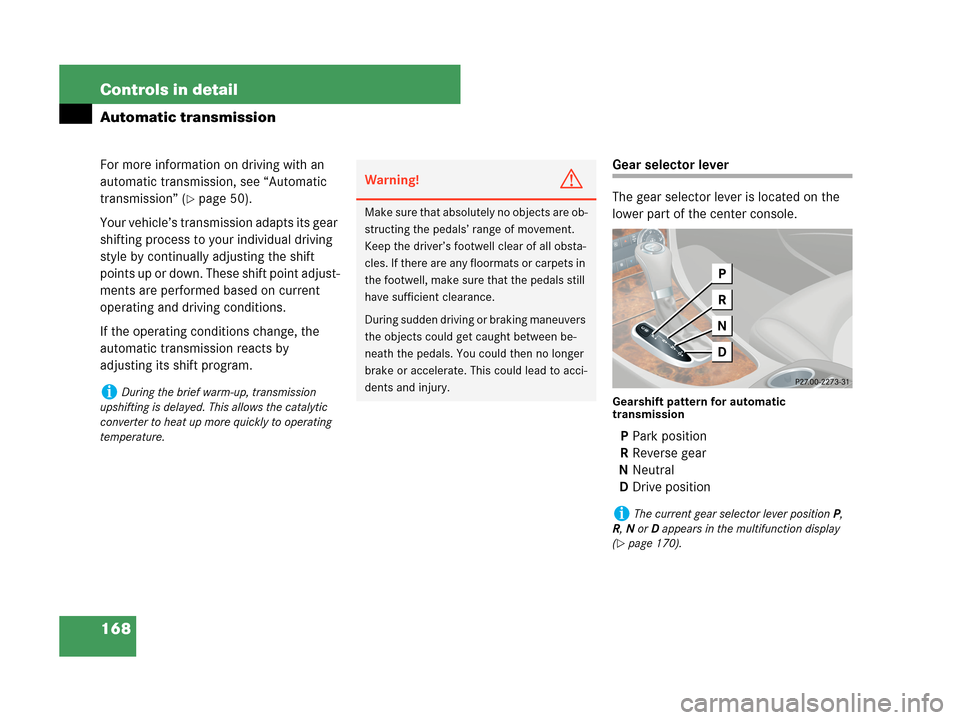
168 Controls in detail
Automatic transmission
For more information on driving with an
automatic transmission, see “Automatic
transmission” (
�page 50).
Your vehicle’s transmission adapts its gear
shifting process to your individual driving
style by continually adjusting the shift
points up or down. These shift point adjust-
ments are performed based on current
operating and driving conditions.
If the operating conditions change, the
automatic transmission reacts by
adjusting its shift program.
Gear selector lever
The gear selector lever is located on the
lower part of the center console.
Gearshift pattern for automatic
transmission
PPark position
RReverse gear
NNeutral
DDrive position
iDuring the brief warm-up, transmission
upshifting is delayed. This allows the catalytic
converter to heat up more quickly to operating
temperature.
Warning!G
Make sure that absolutely no objects are ob-
structing the pedals’ range of movement.
Keep the driver’s footwell clear of all obsta-
cles. If there are any floormats or carpets in
the footwell, make sure that the pedals still
have sufficient clearance.
During sudden driving or braking maneuvers
the objects could get caught between be-
neath the pedals. You could then no longer
brake or accelerate. This could lead to acci-
dents and injury.
iThe current gear selector lever positionP,
R,N orD appears in the multifunction display
(
�page 170).
Page 170 of 481
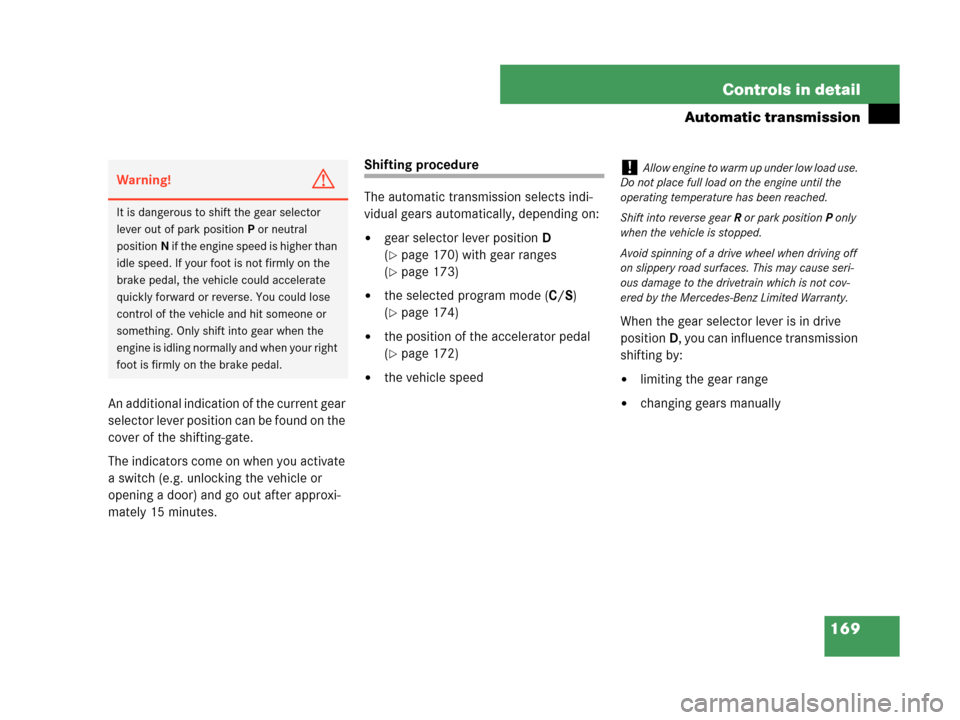
169 Controls in detail
Automatic transmission
An additional indication of the current gear
selector lever position can be found on the
cover of the shifting-gate.
The indicators come on when you activate
a switch (e.g. unlocking the vehicle or
opening a door) and go out after approxi-
mately 15 minutes.
Shifting procedure
The automatic transmission selects indi-
vidual gears automatically, depending on:
�gear selector lever positionD
(
�page 170) with gear ranges
(
�page 173)
�the selected program mode (C/S)
(
�page 174)
�the position of the accelerator pedal
(
�page 172)
�the vehicle speedWhen the gear selector lever is in drive
positionD, you can influence transmission
shifting by:�limiting the gear range
�changing gears manually
Warning!G
It is dangerous to shift the gear selector
lever out of park positionP or neutral
positionN if the engine speed is higher than
idle speed. If your foot is not firmly on the
brake pedal, the vehicle could accelerate
quickly forward or reverse. You could lose
control of the vehicle and hit someone or
something. Only shift into gear when the
engine is idling normally a n d w h e n y o u r r i g h t
foot is firmly on the brake pedal.
!Allow engine to warm up under low load use.
Do not place full load on the engine until the
operating temperature has been reached.
Shift into reverse gearR or park positionP only
when the vehicle is stopped.
Avoid spinning of a drive wheel when driving off
on slippery road surfaces. This may cause seri-
ous damage to the drivetrain which is not cov-
ered by the Mercedes-Benz Limited Warranty.
Page 172 of 481
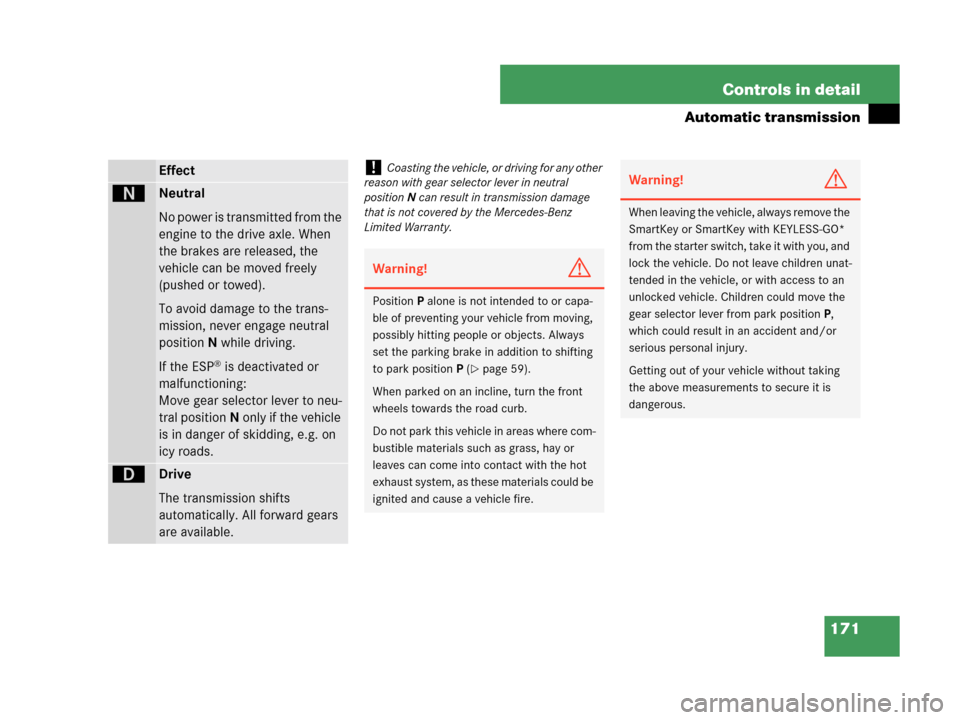
171 Controls in detail
Automatic transmission
Effect
ëNeutral
No power is transmitted from the
engine to the drive axle. When
the brakes are released, the
vehicle can be moved freely
(pushed or towed).
To avoid damage to the trans-
mission, never engage neutral
positionN while driving.
If the ESP
® is deactivated or
malfunctioning:
Move gear selector lever to neu-
tral positionN only if the vehicle
is in danger of skidding, e.g. on
icy roads.
êDrive
The transmission shifts
automatically. All forward gears
are available.
!Coasting the vehicle, or driving for any other
reason with gear selector lever in neutral
positionN can result in transmission damage
that is not covered by the Mercedes-Benz
Limited Warranty.
Warning!G
PositionP alone is not intended to or capa-
ble of preventing your vehicle from moving,
possibly hitting people or objects. Always
set the parking brake in addition to shifting
to park positionP (
�page 59).
When parked on an incline, turn the front
wheels towards the road curb.
Do not park this vehicle in areas where com-
bustible materials such as grass, hay or
leaves can come into contact with the hot
exhaust system, as these materials could be
ignited and cause a vehicle fire.
Warning!G
When leaving the vehicle, always remove the
SmartKey or SmartKey with KEYLESS-GO*
from the starter switch, take it with you, and
lock the vehicle. Do not leave children unat-
tended in the vehicle, or with access to an
unlocked vehicle. Children could move the
gear selector lever from park positionP,
which could result in an accident and/or
serious personal injury.
Getting out of your vehicle without taking
the above measurements to secure it is
dangerous.
Page 173 of 481
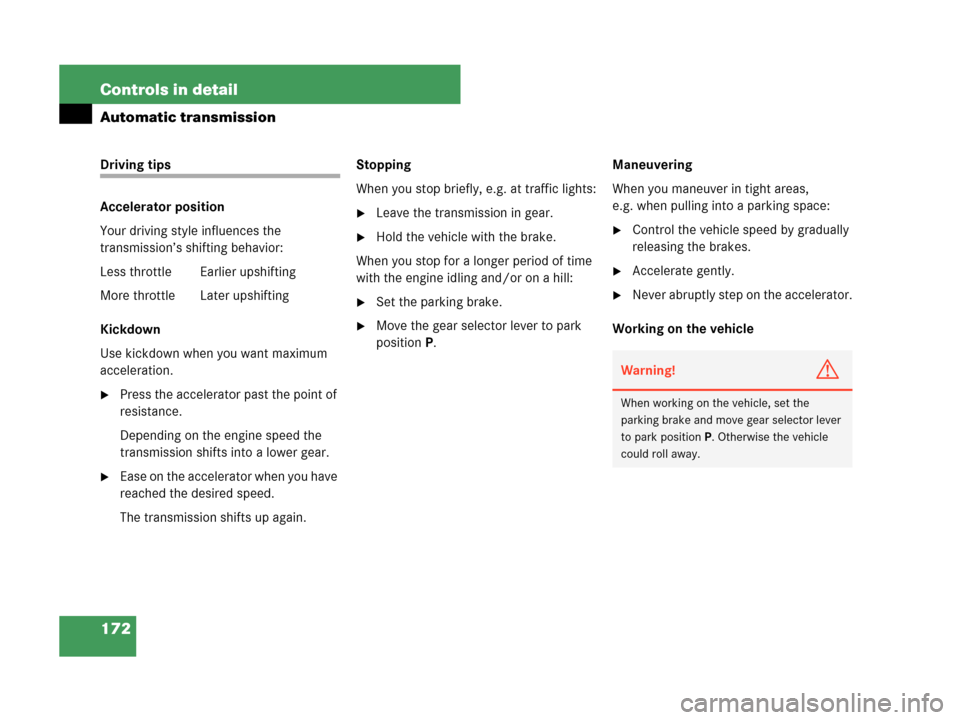
172 Controls in detail
Automatic transmission
Driving tips
Accelerator position
Your driving style influences the
transmission’s shifting behavior:
Less throttle Earlier upshifting
More throttle Later upshifting
Kickdown
Use kickdown when you want maximum
acceleration.
�Press the accelerator past the point of
resistance.
Depending on the engine speed the
transmission shifts into a lower gear.
�Ease on the accelerator when you have
reached the desired speed.
The transmission shifts up again.Stopping
When you stop briefly, e.g. at traffic lights:
�Leave the transmission in gear.
�Hold the vehicle with the brake.
When you stop for a longer period of time
with the engine idling and/or on a hill:
�Set the parking brake.
�Move the gear selector lever to park
positionP.Maneuvering
When you maneuver in tight areas,
e.g. when pulling into a parking space:
�Control the vehicle speed by gradually
releasing the brakes.
�Accelerate gently.
�Never abruptly step on the accelerator.
Working on the vehicle
Warning!G
When working on the vehicle, set the
parking brake and move gear selector lever
to park positionP. Otherwise the vehicle
could roll away.
Page 176 of 481
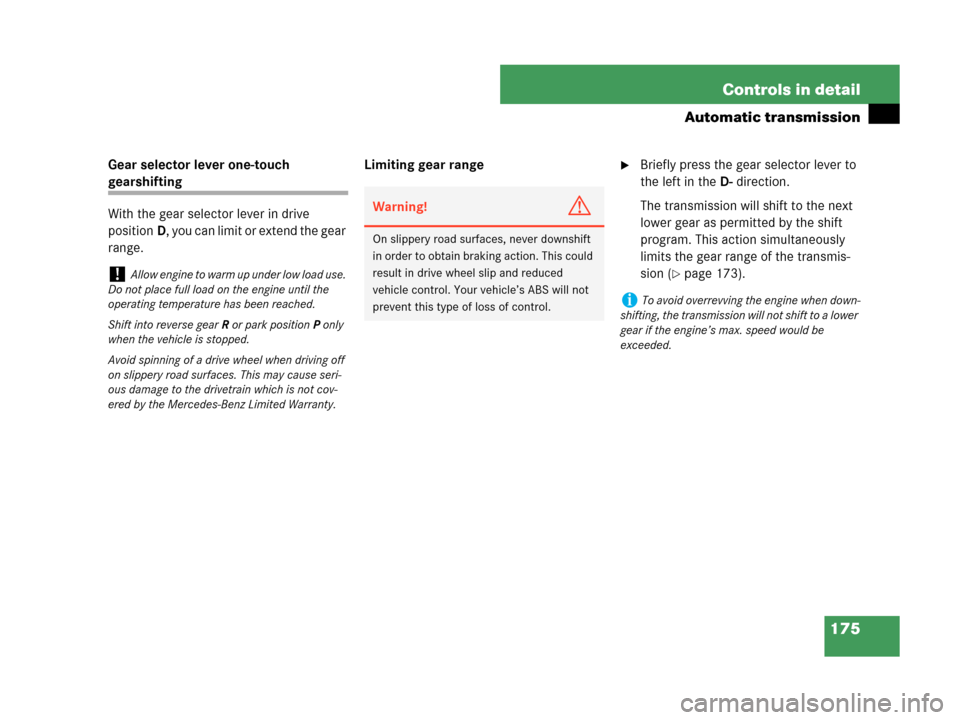
175 Controls in detail
Automatic transmission
Gear selector lever one-touch
gearshifting
With the gear selector lever in drive
positionD, you can limit or extend the gear
range.Limiting gear range
�Briefly press the gear selector lever to
the left in theD-direction.
The transmission will shift to the next
lower gear as permitted by the shift
program. This action simultaneously
limits the gear range of the transmis-
sion (
�page 173).!Allow engine to warm up under low load use.
Do not place full load on the engine until the
operating temperature has been reached.
Shift into reverse gearR or park positionP only
when the vehicle is stopped.
Avoid spinning of a drive wheel when driving off
on slippery road surfaces. This may cause seri-
ous damage to the drivetrain which is not cov-
ered by the Mercedes-Benz Limited Warranty.
Warning!G
On slippery road surfaces, never downshift
in order to obtain braking action. This could
result in drive wheel slip and reduced
vehicle control. Your vehicle’s ABS will not
prevent this type of loss of control.
iTo avoid overrevving the engine when down-
shifting, the transmission will not shift to a lower
gear if the engine’s max. speed would be
exceeded.
Page 178 of 481
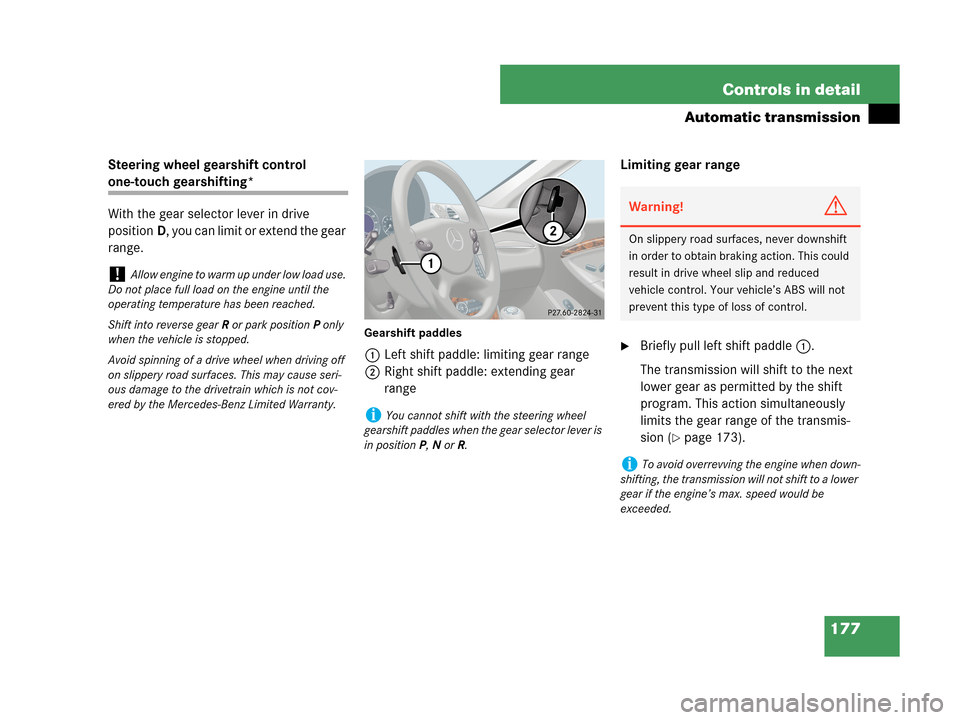
177 Controls in detail
Automatic transmission
Steering wheel gearshift control
one-touch gearshifting*
With the gear selector lever in drive
positionD, you can limit or extend the gear
range.
Gearshift paddles
1Left shift paddle: limiting gear range
2Right shift paddle: extending gear
rangeLimiting gear range�Briefly pull left shift paddle1.
The transmission will shift to the next
lower gear as permitted by the shift
program. This action simultaneously
limits the gear range of the transmis-
sion (
�page 173).
!Allow engine to warm up under low load use.
Do not place full load on the engine until the
operating temperature has been reached.
Shift into reverse gearR or park positionP only
when the vehicle is stopped.
Avoid spinning of a drive wheel when driving off
on slippery road surfaces. This may cause seri-
ous damage to the drivetrain which is not cov-
ered by the Mercedes-Benz Limited Warranty.
iYou cannot shift with the steering wheel
gearshift paddles when the gear selector lever is
in positionP,N orR.
Warning!G
On slippery road surfaces, never downshift
in order to obtain braking action. This could
result in drive wheel slip and reduced
vehicle control. Your vehicle’s ABS will not
prevent this type of loss of control.
iTo avoid overrevving the engine when down-
shifting, the transmission will not shift to a lower
gear if the engine’s max. speed would be
exceeded.
Page 181 of 481
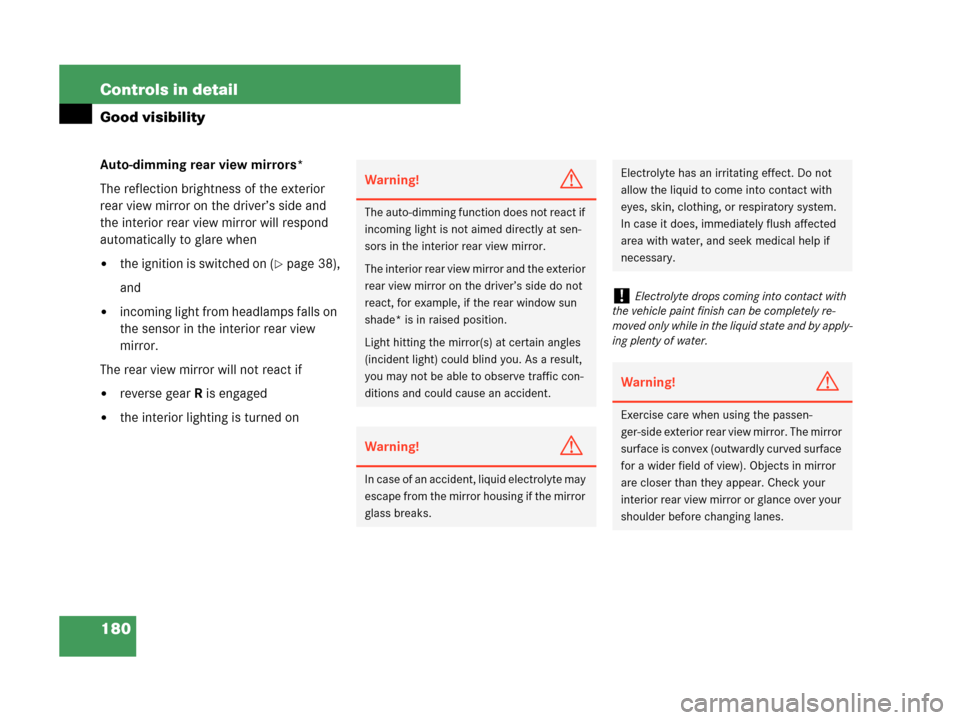
180 Controls in detail
Good visibility
Auto-dimming rear view mirrors*
The reflection brightness of the exterior
rear view mirror on the driver’s side and
the interior rear view mirror will respond
automatically to glare when
�the ignition is switched on (�page 38),
and
�incoming light from headlamps falls on
the sensor in the interior rear view
mirror.
The rear view mirror will not react if
�reverse gearR is engaged
�the interior lighting is turned on
Warning!G
The auto-dimming function does not react if
incoming light is not aimed directly at sen-
sors in the interior rear view mirror.
The interior rear view mirror and the exterior
rear view mirror on the driver’s side do not
react, for example, if the rear window sun
shade* is in raised position.
Light hitting the mirror(s) at certain angles
(incident light) could blind you. As a result,
you may not be able to observe traffic con-
ditions and could cause an accident.
Warning!G
In case of an accident, liquid electrolyte may
escape from the mirror housing if the mirror
glass breaks.
Electrolyte has an irritating effect. Do not
allow the liquid to come into contact with
eyes, skin, clothing, or respiratory system.
In case it does, immediately flush affected
area with water, and seek medical help if
necessary.
!Electrolyte drops coming into contact with
the vehicle paint finish can be completely re-
moved only while in the liquid state and by apply-
ing plenty of water.
Warning!G
Exercise care when using the passen-
ger-side exterior rear view mirror. The mirror
surface is convex (outwardly curved surface
for a wider field of view). Objects in mirror
are closer than they appear. Check your
interior rear view mirror or glance over your
shoulder before changing lanes.
Page 182 of 481
181 Controls in detail
Good visibility
Sun visors
The sun visors protect you from sun glare
while driving.
�Swing sun visor4 down when you
experience glare.1Vanity mirror lamp
2Vanity mirror cover
3Mounting
4Sun visor
�To use the illuminated vanity mirror, lift
up vanity mirror cover2.If sunlight enters through a side window:
�disengage sun visor from mounting3.
�pivot sun visor to the side.
The sun visors are extendable.
�Adjust the sun visors by pushing or
pulling in the direction of the arrows.
Warning!G
Do not use the vanity mirror while driving.
Keep the vanity mirror in the sun visors
closed while vehicle is in motion. Reflected
glare can endanger you and others.
iIf sun visor4 is disengaged from
mounting3 with vanity mirror cover2 open,
vanity mirror lamp1 will switch off.
!Close vanity mirror cover2 (if open) before
you disengage the sun visor4 from
mounting3 and pivot it to the side.